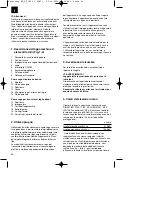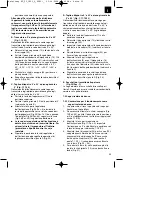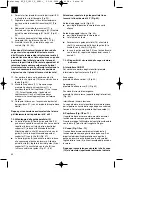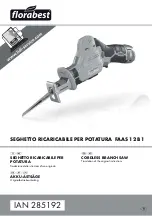
Cutting narrow workpieces (Fig. 47)
Be sure to use a push stick (9) when making
longitudinal cuts in workpieces smaller than 120 mm
in width. (see also 7.2.5/C)
Cutting very narrow workpieces (Fig. 48)
Be sure to use a push block when making longitudinal
cuts in very narrow workpieces with a width of 30 mm
and less. (see also 7.2.3 D)
B Making angular cuts (Fig. 35,49)
Angle cuts must always be used using the parallel
stop (14).
앬
Set the blade (4) to the desired angle. To do this,
release the angle adjustment lever (Fig. 35 / Item
3) and move the machine head (17) to the left
until the required angle is reached on the scale
(34) (see also 7.1.3/C). Then tighten the angle
adjustment lever again.
앬
Adjust the parallel stop (14) to suit the workpiece
width and height. (see also 7.2.2).
앬
Complete the cut to suit the workpiece width.
(See A)
C Making cross cuts (Fig. 50/51)
앬
Slide the cross stop (52) into the groove (47) in
the saw bench and adjust to the required angle.
Undo the toggle screw (48) for this purpose and
adjust it so that the pointer (49) indicates the
required angle on the scale (50). Tighten the
toggle screw (Fig. 48) again. The stop rail on the
cross stop can be moved sideways to suit the
application. To do this, undo the knurled nut (51),
adjust the stop and then tighten the knurled nut
again.
Important. The cross stop may project into
the saw blade in certain circumstances.
Maintain a minimum distance of 20 mm from
the saw blade at all times.
앬
Press the workpiece firmly against the cross stop.
앬
Switch on the saw (see also 7.2.3/A)
앬
When you have switched on the saw, wait until
the saw blade (4) has reached maximum speed.
앬
Push the cross stop (52) and the workpiece
toward the blade (4) in order to make the cut.
Important. Always hold the part of the
workpiece that is controlled by the cross
stop. Never hold the part which is to be cut
off.
앬
Push the cross stop (52) forward until the
workpiece is cut all the way through.
앬
Switch off the saw again.
앬
Do not remove the off-cut until the blade has
stopped rotating.
8. Changing the saw blade and fine
adjustment
Always pull out the power plug before carrying
out maintenance and setting work.
8.1 Adjusting the parallel stop (Fig. 52)
Adjust the parallel stop (14) so that it touches the
saw blade (4).
Adjust the parallel stop using the screws (A) so that it
is in line with the saw blade.
8.2 Saw blade change (Fig. 53 – 57)
앬
Move the saw to the crosscut and miter saw
mode (see also 7.1.1).
앬
Press the saw shaft lock (41) with one hand
while holding the wrench (7) on the flange bolt
(39) with the other.
앬
Firmly press on the saw shaft lock (41) and
slowly rotate the flange bolt (39) in clockwise
direction. The saw shaft lock (41) engages after
no more than one rotation.
앬
Now, using a little more force, slacken the flange
bolt (39) in the clockwise direction.
앬
Turn the flange screw (39) right out and remove
the external flange (40).
앬
Take the blade (4) off the inner flange and pull
out downwards. To do this, release the lowering
lock and open the saw blade guard (see also
point 7.1.2/1.).
앬
Carefully clean the flange screw (39), outer
flange (40) and inner flange.
앬
Fit and fasten the new saw blade (4) in reverse
order.
앬
Important.
The cutting angle of the teeth, in
other words the direction of rotation of the saw
blade (4) must coincide with the direction of the
arrow on the housing.
앬
Check to make sure that all safety devices are
properly mounted and in good working condition
before you begin working with the saw again.
앬
Important. Every time that you change the saw
blade, check to see that it spins freely in both
perpendicular and 45° angle settings.
앬
Important. The work to change and align the saw
blade (4) must be carried out correctly.
9. Replacing the power cable
If the power cable for this equipment is damaged, it
must be replaced by the manufacturer or its after-
sales service or similarly trained personnel to avoid
danger.
GB
26
Anleitung RT_FF_1825_U_SPK1:_ 23.06.2008 9:42 Uhr Seite 26
















































